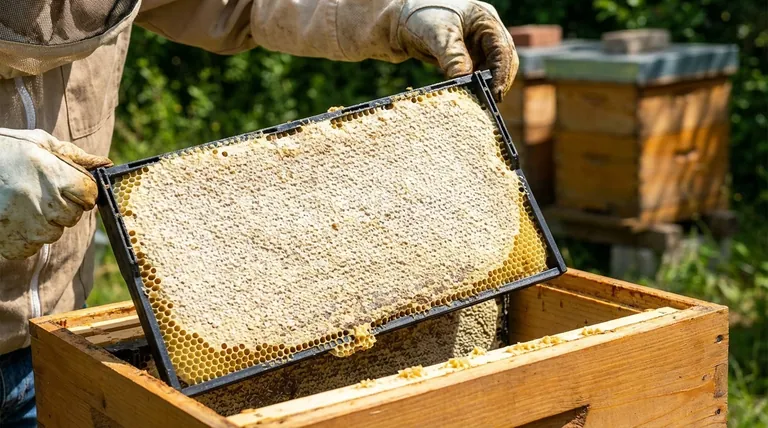To inspect honey frames, you are primarily looking for the amount of honey that the bees have sealed with a waxy, white-to-yellow coating. This is known as capped honey. The quantity and coverage of this capping is the single most important indicator for making key management decisions for your hive.
A honey frame inspection is not just a casual check-in; it is a critical diagnostic process. You are reading the bees' signals to determine one of two things: whether they need more space to expand, or whether their honey is perfectly ripe for harvesting.

The Two Primary Goals of Honey Frame Inspection
Understanding why you are inspecting the frames is the first step. Your actions will differ depending on whether your goal is to manage the hive's space or to prepare for honey extraction. Both goals, however, rely on correctly interpreting the amount of capped honey.
Goal 1: Assessing the Need for More Space
Your primary goal during a routine inspection is to ensure the colony has enough room to work and expand. A crowded hive is a primary trigger for swarming.
The 70-80% Rule
When you open a honey super (the box containing the frames), quickly assess how many of the frames are full of capped honey. The generally accepted rule is that if seven or eight out of ten frames are full, the bees are running out of space.
Preventing Congestion
This 70-80% threshold is the signal to add another honey super on top of the current one. Providing this space before they are completely full prevents congestion and encourages the bees to continue foraging and storing honey rather than preparing to swarm.
Goal 2: Determining Harvest Readiness
The second major goal is to determine if the honey is ready to be harvested. Removing honey too early can lead to spoilage, as its moisture content will be too high.
Capped Honey is Ripe Honey
The bees are master chemists. They dehydrate the nectar they collect until it reaches the perfect moisture content (around 18%) to prevent fermentation. Once this is achieved, they seal the cell with a wax cap.
Look for Fully Capped Frames
A frame that is fully or nearly fully capped is the clearest sign that the honey is "ripe" and ready for extraction. This waxy seal is your guarantee that the honey has the appropriate moisture level and will store properly after you harvest it.
Common Pitfalls in Frame Inspection
Interpreting the frames correctly is crucial. Acting too early or too late based on your inspection has direct consequences for the health of your hive and the quality of your honey.
Acting Too Early
Adding a super when only a few frames are full can be counterproductive. The bees will have a much larger space to patrol and regulate temperature, which can stress the colony, especially smaller or newer ones.
Harvesting Uncapped Honey
Harvesting frames with large patches of uncapped honey is a significant risk. This "unripe" honey has a high moisture content and is very likely to ferment in storage, spoiling your entire harvest.
Post-Harvest Storage
After extraction, the empty frames, often called "stickies" because of residual honey, must be protected. Storing them in a location that is not moth-proof can lead to a wax moth infestation, which will destroy the delicate comb you hope to reuse next season.
Making the Right Decision
Your inspection should always lead to a clear action. Use the state of the frames to guide your next step with confidence.
- If your primary focus is hive management: Look at the super as a whole. If 70% or more of the frames are full and capped, it is time to add another honey super.
- If your primary focus is honey harvesting: Look at individual frames. Only pull frames for extraction that are at least 80-90% covered with a solid wax capping.
Ultimately, a proper frame inspection allows you to work in partnership with your bees, responding to their needs and harvesting their surplus at the perfect moment.
Summary Table:
| Inspection Goal | Key Indicator | Action to Take |
|---|---|---|
| Assess Hive Space | 70-80% of frames are full & capped | Add another honey super to prevent swarming |
| Determine Harvest Readiness | Individual frames are 80-90% fully capped | Harvest frames for extraction; honey is ripe |
Ready to equip your apiary for efficient inspections and bountiful harvests?
As a trusted wholesale supplier for commercial apiaries and distributors, HONESTBEE provides the durable, high-quality beekeeping supplies and equipment you need. From honey supers and frames to essential extraction tools, our products are designed to support the scale and demands of your operation.
Contact us today to discuss your wholesale needs and discover how we can help your business thrive.
Get in Touch for Wholesale Pricing
Visual Guide

Related Products
- Plastic Bee Frame Beekeeping Hive Frames for Wholesale
- Assembled Wooden Bee Frames with Beeswax Foundation Ready to Use by HONESTBEE
- HONESTBEE Wired and Assembled Wooden Bee Frames Foundation for a Thriving Hive
- Professional 500g Sectional Comb Honey Frame System for Beekeeping
- Assembled Wooden Bee Frames with Plastic Foundation for Durability and Convenience by HONESTBEE
People Also Ask
- Are plastic frames good? Boost Apiary Efficiency with Durable, Pest-Resistant Frames
- What is a general rule for beekeepers with many hives regarding frame choice? Maximize Efficiency with Plastic Frames
- What are the advantages of plastic frames for beehives? Boost Apiary Efficiency & Durability
- Why are plastic frames popular in commercial beekeeping? Boost Efficiency & Durability at Scale
- What are the main types of frames available for beehives? Wood vs. Plastic for Your Apiary



















